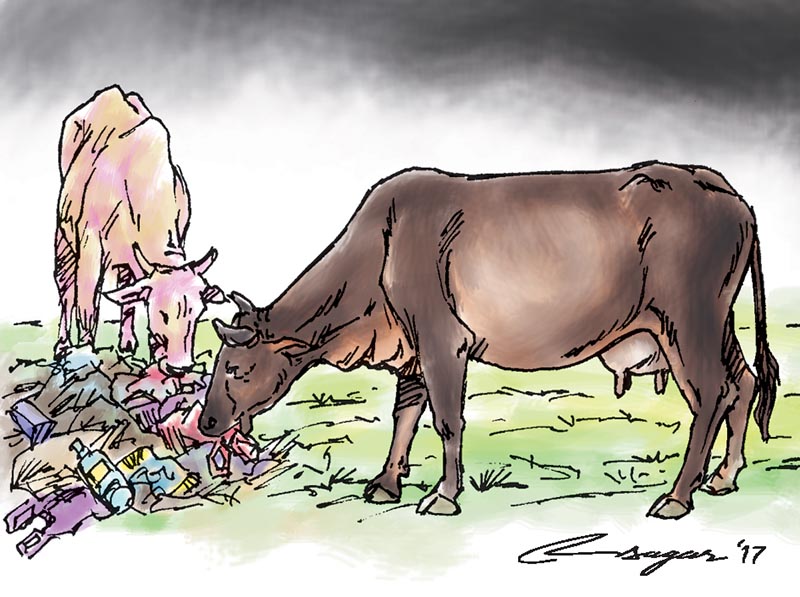Plastic pollution: Effects on environment
During burning, all types of plastic emit some very toxic gases, so it is not considered a way to get rid of the accumulated load of plastic on earth. Only a few types of plastic can be recycled another two or three times
Besides the radioactive waste produced by atomic plants, and carbon monoxide, carbon dioxide and some other dangerous gases emitted due to the burning of hydrocarbon fuel, the next threat to our civilization is from the continuous deposit of non-biodegradable plastic on the surface of the earth. The land, the sea surface, the sea bottom, the mountain valleys, the poles, no region is now devoid of the presence of plastic.
Plastic, in its various forms, is limiting our days on earth by influencing various aspects of life. Many scientists and environmental specialists all over the world have studied the harmful effect of plastic in detail and all of them are of the same view regarding the degree of harm they represent. Apart from the introduction of many types of poisons in environment and in our body, plastic also block the sewage system of urban areas, adversely affect the riverbed and estuary and bring destructive change in the biodiversity to a large extent.
Plastic are petroleum-based products, and they are used in various forms. Each form of plastic production requires huge amount of mineral oil. The basic principle for the production of plastic is the conversion of natural gas or crude oil components into commoners like ethylene, propylene, butane and styrene in presence of catalysts. Then, these monomers are chemically bonded to a chain called a polymer. Different additives (Chlorine, Nitrogen, Fluorine, Oxygen etc.) and color material make different types of plastics.
The low-density polyethylene is the form of plastic that is used for production of polythene bags. High-density polyethylene is used for production of buckets, bowls, cups, and plates, jackets for cement and fertilizers and large sized bottles. Polyvinyl chloride is used for productions of rexine shoe soles, toys, pipe, tubing blood and plasma transfusion bags etc.
Polycarbonate is used to produce baby feeding bottles, large water bottles etc. The thermo set poly urethane is used to produce all types of foams. Polypropylenes is used to prepare packaging material for edible items, luggage carried and textile cones, polyethylene terephthalate is used to prepare bottles for many purposes.
All types of plastic require a huge amount of mineral oil for their production and transportation. So, the process of plastic synthesis causes depletion of hydrocarbon fuel storage at a high rate and produces dangerous fuel. Polyurethane alone consumes 11 percent of total production of dangerous ‘phosgene’ gas of the world during its formation.
There are occupational hazards for workers and the death of a huge number of humans, animal and plants due to accidental leakage. Plastic themselves are also toxic and the key for their toxicity remains in the history of their production.
Plastic are the products of several types of monomers as a result of polymerization. Almost all such monomers that make up plastic are carcinogenic, mutagenic of the endocrine system. As the polymerization process cannot be made perfect at any time some toxic monomers are present in plastics.
Beside these loose monomers, other toxic materials are also present in plastics. Among them, the colour materials and other additives like formatting agents, plasticisers etc. which are used during preparation of various types of plastic and remain in it are very toxic and most of them are carcinogenic. They all remain poorly bonded with the plastic polymers and tend to leach out and mix with the adhered materials.
During burning, all types of plastic emit some very toxic gases, so it is not considered a way to get rid of the accumulated load of plastic on earth. Only a few types of plastic can be recycled another two or three times but in the process it is hazardous for the health of the people who are engaged in collection of thrown plastic from dirty dustbins. During recycling many toxic gases are emitted and the quality of the recycled plastic is worse than the original one.
The process is also not economically feasible. Recycling of plastic is not a common practice in our country. So, all types of plastic are born to remain as source of continuous threat for ages.
Animals are not able to distinguish plastic from straw and other cellulose containing materials. So it is not very uncommon for the herbivorous animals, mainly cattle and buffaloes, and sheep and goats to consume plastic packets (mainly of Polyethylene and Polypropylene origin) thinking them to be food.
These animals cannot digest them, and show the symptoms of recurrent bloat and are generally treated by carminative for a long period. Continuous accumulation of such plastic packets happen inside the first camper of their four-chambered stomach.
Accumulation of many types of drugs inside the cells could affect the normal functioning of a cell, tissue or organ of an animal or human being. Continuous deposition of various medicinal drugs, agricultural insecticides and pesticides, poisonous adulterating chemicals, toxic preservatives and other colouring materials used in fast food items and such various types of toxins together in the cellular level are dangerous, and pose a great threat to mankind.
As human beings are at the top of food chain, they ingest such drugs through consumption of food and food products made from meat, milk and eggs.






